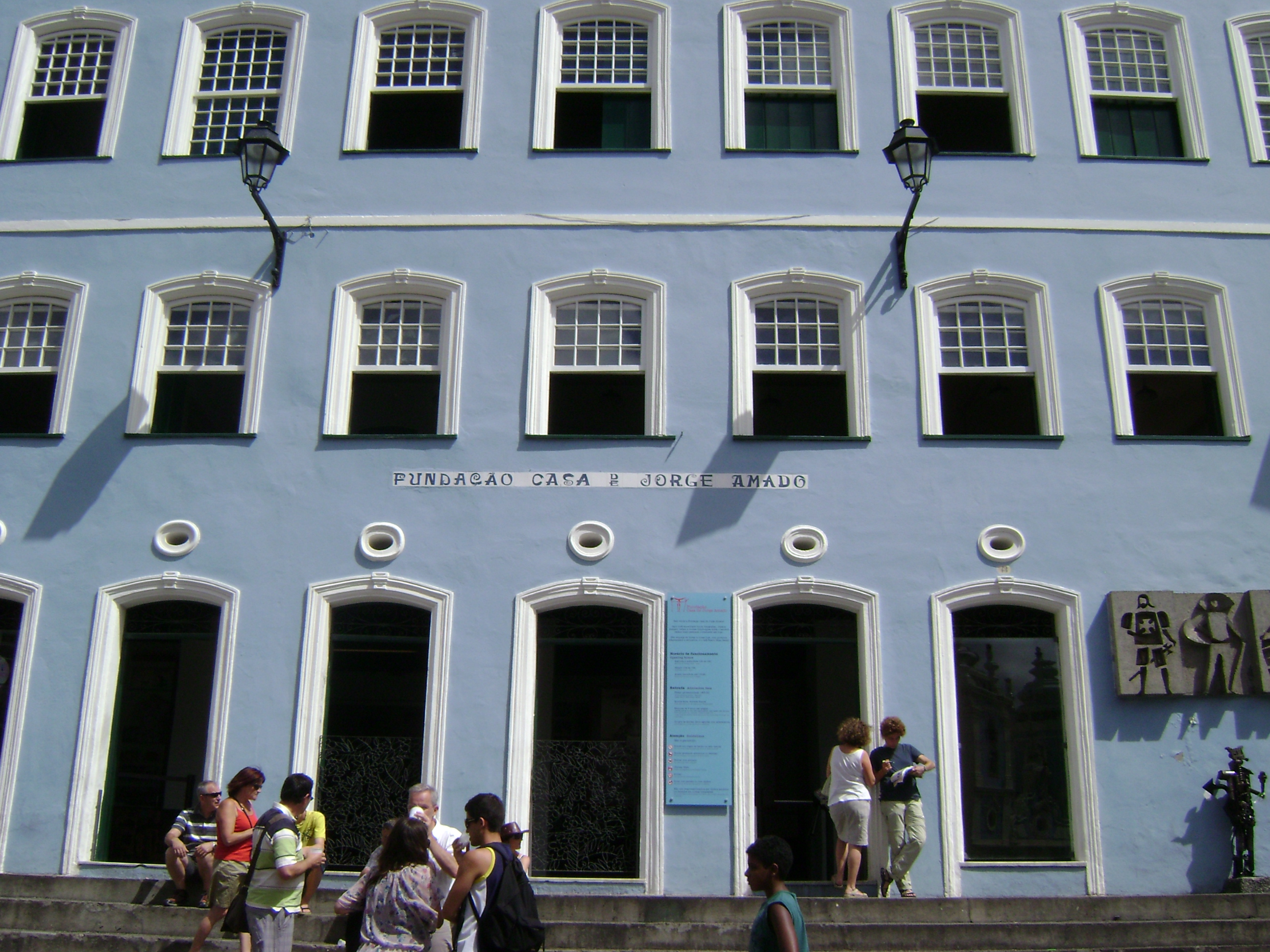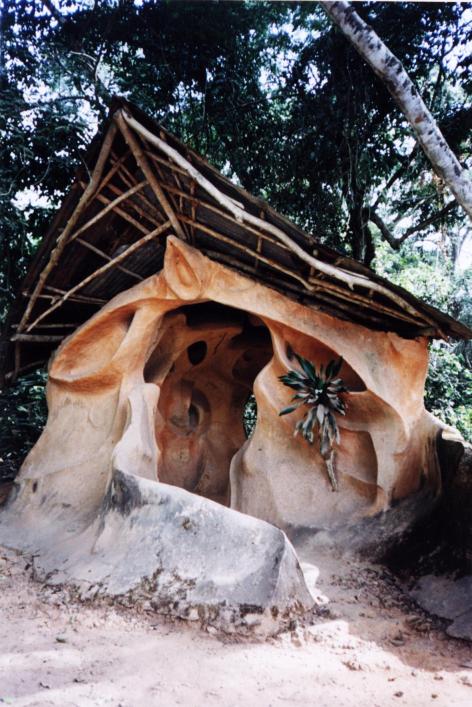|
Ilê Axé Opô Afonjá
Ilê Axé Opó Afonjá, also known as Centro Santa Cruz Axé of Opó Afonjá or Casa de Xangô, is a Candomblé Candomblé#Houses_of_Worship, terreiro in Salvador, Bahia, Salvador, Bahia, Brazil. It was founded by Eugênia Anna Santos (1869-1938), better known as Mãe Aninha, in 1910. The terreiro is located in the Cabula neighborhood on Rua de São Gonçalo do Retiro. Ilê Axé Opó Afonjá was the second Afro-Brazilian religious place of worship to receive heritage status from the Brazilian National Historic and Artistic Heritage Institute (IPHAN). Ilê Axé Opó Afonjá was formed in 1910 by a group that separated from Ilê Axé Iyá Nassô Oká, or the Casa Branca do Engenho Velho. It is one of the primary temples of the Candomblé Ketu, Ketu sect of Candomblé. A terreiro of the same name was founded by Mãe Aninha in Rio de Janeiro. In 1967 the Terreiro was visited by Jean-Paul Sartre and Simone de Beauvoir who were invited by Jorge Amado and Zélia Gattai. Grounds and str ... [...More Info...] [...Related Items...] OR: [Wikipedia] [Google] [Baidu] |
Candomblé
Candomblé () is an African diaspora religions, African diasporic religion that developed in Brazil during the 19th century. It arose through a process of syncretism between several of the traditional religions of West and Central Africa, especially those of Yoruba religion, the Yoruba, Bantu mythology, Bantu, and Gbe languages, Gbe, coupled with influences from Roman Catholicism. There is no central authority in control of Candomblé, which is organized around autonomous ''terreiros'' (houses). Candomblé venerates spirits, known varyingly as ''Orisha, orixás'', ''inkice'', or ''vodun'', which are deemed subservient to a transcendent creator god, Olorun, Oludumaré. Deriving their names and attributes from traditional West African deities, the ''orixás'' are linked with Roman Catholic saints. Each individual is believed to have a tutelary ''orixá'' who has been connected to them since before birth and who informs their personality. An initiatory tradition, Candomblé's member ... [...More Info...] [...Related Items...] OR: [Wikipedia] [Google] [Baidu] |
Jorge Amado
Jorge Amado ( 10 August 1912 – 6 August 2001) was a Brazilian writer of the modernist school. He remains the best-known of modern Brazilian writers, with his work having been translated into some 49 languages and popularized in film, including ''Dona Flor and Her Two Husbands (novel), Dona Flor and Her Two Husbands'' in 1976, and having been nominated for the Nobel Prize in Literature 7 times. His work reflects the image of a Mestiço Brazil and is marked by religious syncretism. He depicted a cheerful and optimistic country that was beset, at the same time, with deep social and economic differences. He occupied the 23rd chair of the Brazilian Academy of Letters from 1961 until his death in 2001. He won the 1984 Nonino#Winners, International Nonino Prize in Italy. He also was Chamber of Deputies (Brazil), Federal Deputy for São Paulo (state), São Paulo as a member of the Brazilian Communist Party between 1947 and 1951. Biography Amado was born on Saturday, 10 August 1912, ... [...More Info...] [...Related Items...] OR: [Wikipedia] [Google] [Baidu] |
Candomblé Temples
Candomblé () is an African diaspora religions, African diasporic religion that developed in Brazil during the 19th century. It arose through a process of syncretism between several of the traditional religions of West and Central Africa, especially those of Yoruba religion, the Yoruba, Bantu mythology, Bantu, and Gbe languages, Gbe, coupled with influences from Roman Catholicism. There is no central authority in control of Candomblé, which is organized around autonomous ''terreiros'' (houses). Candomblé venerates spirits, known varyingly as ''Orisha, orixás'', ''inkice'', or ''vodun'', which are deemed subservient to a transcendent creator god, Olorun, Oludumaré. Deriving their names and attributes from traditional West African deities, the ''orixás'' are linked with Roman Catholic saints. Each individual is believed to have a tutelary ''orixá'' who has been connected to them since before birth and who informs their personality. An initiatory tradition, Candomblé's member ... [...More Info...] [...Related Items...] OR: [Wikipedia] [Google] [Baidu] |
Organisations Based In Salvador, Bahia
An organization or organisation (Commonwealth English; see spelling differences) is an entity—such as a company, or corporation or an institution (formal organization), or an association—comprising one or more people and having a particular purpose. Organizations may also operate secretly or illegally in the case of secret societies, criminal organizations, and resistance movements. And in some cases may have obstacles from other organizations (e.g.: MLK's organization). What makes an organization recognized by the government is either filling out incorporation or recognition in the form of either societal pressure (e.g.: Advocacy group), causing concerns (e.g.: Resistance movement) or being considered the spokesperson of a group of people subject to negotiation (e.g.: the Polisario Front being recognized as the sole representative of the Sahrawi people and forming a partially recognized state.) Compare the concept of social groups, which may include non-organizat ... [...More Info...] [...Related Items...] OR: [Wikipedia] [Google] [Baidu] |
Religious Buildings And Structures In Salvador, Bahia
Religion is a range of social system, social-cultural systems, including designated religious behaviour, behaviors and practices, morals, beliefs, worldviews, religious text, texts, sanctified places, prophecies, ethics in religion, ethics, or religious organization, organizations, that generally relate humanity to supernatural, transcendence (religion), transcendental, and spirituality, spiritual elements—although there is no scholarly consensus over what precisely constitutes a religion. It is an essentially contested concept. Different religions may or may not contain various elements ranging from the divine, sacredness, faith,Tillich, P. (1957) ''Dynamics of faith''. Harper Perennial; (p. 1). and a supernatural being or beings. The origin of religious belief is an open question, with possible explanations including awareness of individual death, a sense of community, and dreams. Religions have sacred histories, narratives, and mythologies, preserved in oral traditions, sac ... [...More Info...] [...Related Items...] OR: [Wikipedia] [Google] [Baidu] |
National Heritage Sites Of Bahia
National may refer to: Common uses * Nation or country ** Nationality – a ''national'' is a person who is subject to a nation, regardless of whether the person has full rights as a citizen Places in the United States * National, Maryland, census-designated place * National, Nevada, ghost town * National, Utah, ghost town * National, West Virginia, unincorporated community Commerce * National (brand), a brand name of electronic goods from Panasonic * National Benzole (or simply known as National), former petrol station chain in the UK, merged with BP * National Book Store, a bookstore and office supplies chain in the Philippines * National Car Rental, an American rental car company * National Energy Systems, a former name of Eco Marine Power * National Entertainment Commission, a former name of the Media Rating Council * National Motor Vehicle Company, Indianapolis, Indiana, USA 1900–1924 * National Radio Company, Malden, Massachusetts, USA 1914–1991 * National Supermarket ... [...More Info...] [...Related Items...] OR: [Wikipedia] [Google] [Baidu] |
Corpus Christi (feast)
The Feast of Corpus Christi (), also known as the Solemnity of the Most Holy Body and Blood of Christ, is a liturgical solemnity celebrating the real presence of Christ in the Eucharist; the feast is observed by the Latin Church, in addition to certain Western Rite Orthodoxy, Western Orthodox, Lutheran, and Anglican churches. Two months earlier, the institution of the Eucharist at the Last Supper is observed on Maundy Thursday in a sombre atmosphere leading to Good Friday. The liturgy on that day also commemorates Christ's washing of the disciples' feet, the institution of the priesthood, and the agony in the Garden of Gethsemane. The feast of Corpus Christi was proposed by Thomas Aquinas, Doctor of the Church, to Pope Urban IV, in order to create a feast focused solely on the Holy Eucharist, emphasizing the joy of the Eucharist being the Body and Blood, Soul and Divinity of Jesus Christ. Having recognized in 1264 the authenticity of the Corporal of Bolsena, Eucharistic Miracle ... [...More Info...] [...Related Items...] OR: [Wikipedia] [Google] [Baidu] |
Mãe Stella De Oxóssi
Mãe Stella de Oxóssi (born Maria Stella de Azevedo Santos, also known as ''Odé Kayodê'', 2 May 1925 – 27 December 2018) was a ''iyalorixá'', or priestess, in the Brazilian Candomblé religion. She was the fifth ''iyalorixá'' (chief priestess) of Ilê Axé Opô Afonjá, a Candomblé ''terreiro'' in Salvador, Bahia, Salvador, Bahia, Brazil. Mãe Stella was trained as a public health nurse. She was initiated into the Candomblé religion in 1939 and became the iyalorixá of Ilê Axé Opô Afonjá in 1976. Mãe Stella is noted for writing on the beliefs and practices of Candomblé for the general public, rather than practitioners. She lived in the interior of Bahia after a stroke and was interred in Salvador after her death in 2018. Early life Mãe Stella de Oxóssi was born in Salvador, the fourth daughter of Esmeraldo Antigno dos Santos and Thomázia de Azevedo Santos. She became an orphan and was raised by her maternal aunt. She studied at the Federal University of Bahia an ... [...More Info...] [...Related Items...] OR: [Wikipedia] [Google] [Baidu] |
Oxum
Oshun (also Ọṣun, Ochún, and Oxúm) is the Yoruba orisha associated with love, sexuality, fertility, femininity, water, destiny, divination, purity, and beauty, and the Osun River, and of wealth and prosperity in the Yoruba religion. She is considered the most popular and venerated of the 401 orishas. In the mythology, Oshun was once the queen consort to King Shango of Oyo, and deified following her death, honored at the Osun-Osogbo Festival, a two-week-long annual festival that usually takes place in August, at the Oṣun-Osogbo Sacred Grove in Osogbo. A violín is a type of musical ceremony in Regla de Ocha performed for Osún. It includes both European classical music and Cuban popular music. Mythology According to the Ifa Literary Corpus, Oshun was the only female Irunmole (primordial spirit) sent to assist Shango to create the world by Olodumare, the Supreme God. The other spirits sent ignored Oshun, who went to Shango for guidance. One version of the story cl ... [...More Info...] [...Related Items...] OR: [Wikipedia] [Google] [Baidu] |
Zélia Gattai
Zélia Gattai Amado de Faria (July 2, 1916 – May 17, 2008) was a Brazilian photographer, memoirist, novelist and author of children's literature, as well as a member of the Brazilian Academy of Letters. Gattai wrote 14 literary works, including children's books, and her own personal memoirs have been widely published. Biography Zélia Gattai was born in São Paulo city in the neighborhood of Paraíso, state of São Paulo, on July 2, 1916, to a family of Italian immigrant. Gattai's father, Ernesto Gattai, was an anarchist and came from the region of Veneto, following the social anarchist experiment called Colônia Cecília that sought to create an anarchist community in the Brazilian jungle. Her father was arrested in 1938 due to political oppression under the Vargas Estado Novo regime. Gattai lived in Paraíso, São Paulo for her entire adolescence. In the 1930s, Zélia Gattai entered the intellectual and social circles of the modernists of São Paulo and Rio de Janeiro, be ... [...More Info...] [...Related Items...] OR: [Wikipedia] [Google] [Baidu] |



